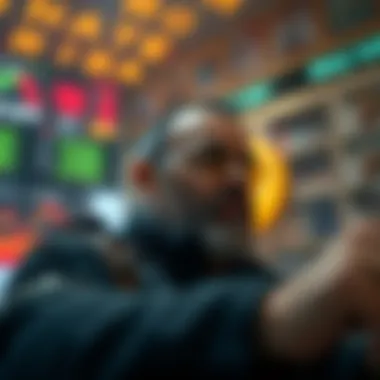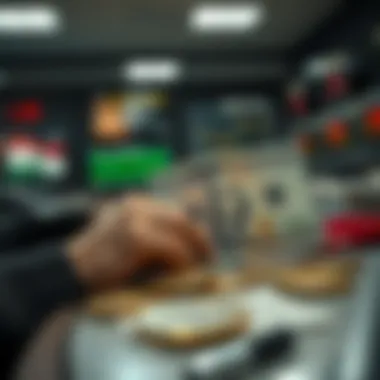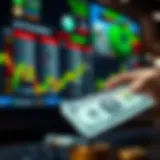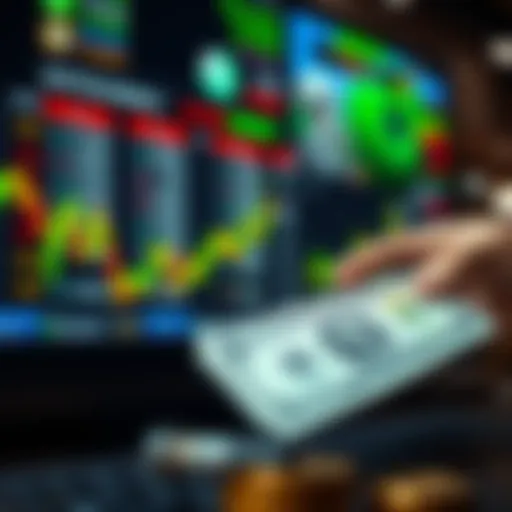Navigating Iraqi Dinar Trading in Forex Market


Intro
The journey into the world of trading the Iraqi Dinar can be as tumultuous as the history of its nation itself. With a past shaped by wars, economic hardships, and significant political shifts, the currency holds a unique position within the foreign exchange market. Trading this currency is not simply about numbers on screens; it encompasses a nuanced understanding of its historical context, current market dynamics, and the factors influencing its value.
In this exploration of Iraqi Dinar trading, we'll peel back the layers to reveal both the challenges and the opportunities that lie within this niche market. From historical insights that inform today's market to the practical strategies that seasoned traders employ, we'll equip investors and analysts alike with valuable knowledge.
By the conclusion of this article, readers will be poised to not only consider the potential gains and risks associated with the Iraqi Dinar but also appreciate the broader economic landscape that impacts this unique currency.
Understanding the Iraqi Dinar
The Iraqi Dinar holds significance not only as a currency but also as a symbol of the country’s economic narrative. Understanding it is vital for anyone interested in trading within the forex market. This section elaborates on the deep-seated history and current standing of the dinar in global trade, offering insights that are crucial for informed investment decisions.
Historical Background
The journey of the Iraqi Dinar began in the 1930s, when it replaced the Indian Rupee as the primary circulating currency in Iraq. It was initially pegged to the British Pound, a decision reflecting the political landscape of the time. Post-2003, after the invasion by U.S. forces, the dinar underwent a significant transformation. The currency was reissued, and the government took steps to stabilize it amid ongoing economic and political turmoil.
Today, the dinar's value is influenced by various factors, including global oil prices, because Iraq's economy is heavily reliant on oil exports. This reliance creates a direct relationship between the dinar and international oil markets, both of which are vital for traders to understand.
Moreover, over the years, inflation has created fluctuations in the dinar's value, impacting its purchasing power. A trader needs to comprehend these historical shifts to make educated forecasts about the currency's future.
Current Status in the Global Market
As of now, the Iraqi Dinar remains a less-traded currency compared to major currencies like the U.S. Dollar or Euro. Yet, it possesses unique characteristics which can present both opportunities and risks for investors. The dinar has remained relatively stable in its exchange rate against the dollar due to the Central Bank of Iraq's interventions in the forex market. This stability creates an interesting point for traders who seek to make short-term gains.
The dinar is often viewed through a speculative lens. Investors assess the potential for the dinar to appreciate, driven by improvements in Iraq's economic situation and greater political stability. However, it's a double-edged sword. Economic sanctions, political instability, and security issues in the region create volatility, which can influence trading outcomes.
"Investing in the Iraqi Dinar is like sailing in a ship with no compass. One must be vigilant and well-informed in these choppy waters."
For anyone engaging in forex trading involving the Iraqi Dinar, a comprehensive grasp of its historical context and current market position is essential. Without this foundation, traders risk making decisions that may not be based on the realities present in both the local and global economies. This understanding helps equip investors to navigate the complexities associated with the currency, thereby enhancing the prospects for successful trading.
Mechanics of Forex Trading
Understanding the mechanics of forex trading is essential for anyone looking to delve into the world of foreign exchange, particularly when it comes to a unique currency like the Iraqi Dinar. The intricacies of this market not only influence how trades are executed but also determine the profitability and risks associated with investing in currencies.
Forex trading operates on a 24-hour basis, with trillions of dollars exchanged daily across the globe. It can be broken down into several key components that contribute to its structure:
Forex Market Structure
The forex market is decentralized and does not have a physical location. Instead, it operates via a network of banks, brokers, and electronic trading platforms around the world. This structure allows for seamless and continuous trading but also introduces complexities that traders must navigate.
Some critical elements of the market structure include:
- Major Markets: The forex market is divided into three major trading sessions: the Asian, European, and North American sessions. Each session has its own characteristics and trading volumes, impacting liquidity and price movements.
- Currency Pairs: In forex, currencies are traded in pairs, with the base currency quoted against the quote currency. For the Iraqi Dinar, traders often focus on pairs like IQD/USD.
- Market Makers: These are firms or individuals who provide liquidity to the market by buying and selling currencies, thus enabling smoother trades for retail traders. They play a pivotal role in determining price levels, especially for less liquid currencies like the Iraqi Dinar.
- Spreads and Pips: Traders need to be aware of spreads, which are the differences between buying (ask) and selling (bid) prices. Additionally, the term pips (percentage in point) is essential for measuring price movements.
The unique structure of the forex market adds layers of complexity for traders, especially for those dealing with smaller, more volatile currencies like the Iraqi Dinar. Understanding these elements can empower traders to make more informed decisions.
Key Players in Forex Trading
When discussing the mechanics of forex trading, it’s crucial to identify the key players involved in the marketplace. Each plays a unique role in shaping market conditions and influencing currency values. The major actors in forex trading include:
- Central Banks: Authorities that manage a country’s currency, money supply, and interest rates. For example, the Central Bank of Iraq is integral to influencing the value of the Iraqi Dinar through its monetary policy decisions.
- Commercial Banks: These financial institutions engage in currency trading for their accounts and also act as intermediaries for traders.
- Hedge Funds and Institutional Investors: These large players often engage in significant trades, which can impact market prices. Their strategies may include speculating based on economic indicators or geopolitical events.
- Retail Traders: This group has grown significantly with the advent of online trading platforms. However, individual retail traders typically trade in much smaller volumes compared to institutional investors and banks.
- Brokers: They facilitate trades between retail traders and the larger financial institutions. The choice of a broker is essential, as different brokers have varying terms and conditions, impacting cost and execution.
Understanding who is participating in the trade can provide insights into market trends, allowing traders to anticipate movements and adjust their strategies accordingly.
Iraqi Dinar in Forex Trading
Trading the Iraqi Dinar on the Forex market offers a fascinating glimpse into the intricacies of global finance. This often overlooked currency has potential that merits serious consideration from traders and investors alike. The significance of the Iraqi Dinar arises not only from its historical background but also from its unique position in contemporary economic discussions.
The Dinar holds a specific place in the foreign exchange landscape, characterized by its fluctuations influenced by a myriad of factors. Investors drawn to trading this currency can discover both challenges and opportunities, but understanding those dynamics is crucial for informed trading.


Liquidity and Availability
The liquidity of the Iraqi Dinar in the Forex market can be regarded as a double-edged sword. While it may not reach the liquidity levels of majors such as the US Dollar or Euro, this currency does have specific availabilities that can favor traders.
- Market Hours: The Forex market operates 24/5 which means traders can access the Dinar through various international trading platforms during business hours. A trader can buy or sell Dinars at their convenience, albeit it may require a price concession due to lower liquidity.
- Brokerage Options: Not every Forex brokerage offers trading in the Iraqi Dinar. Therefore, it’s pivotal for traders to choose platforms that specifically include the Dinar in their offerings. Brokerages like Forex.com or OANDA might be important considerations for a trader interested in this path.
One of the key takeaways is that a trader’s experience may greatly depend on selecting the right broker, as it can directly impact transaction costs and access to the Dinar.
Factors Influencing Dinar Value
Understanding the value of the Iraqi Dinar requires a multifaceted approach, as its worth is shaped by various domestic and global elements.
- Economic Stability: The overall economic conditions within Iraq, such as inflation rates and employment statistics, significantly sway the Dinar's value. A stable economic horizon often correlates with a stronger currency value.
- Oil Prices: Given that Iraq is heavily reliant on oil exports, fluctuations in oil prices can have an immediate effect on the Dinar. A spike in oil prices tends to strengthen the Dinar, while a downturn can erode its value rapidly.
- Political Climate: Iraq’s political stability, or lack thereof, heavily influences investor confidence. Events like elections or security issues can lead to currency volatility, affecting trading strategies.
- Global Economic Trends: Broader factors in the global economy, including shifts in interest rates in major economies, also ripple through to the Dinar. An increase in interest rates elsewhere may draw investment away from Iraq, impacting demand for the currency.
In essence, trading the Iraqi Dinar involves navigating through an intricate web of economic signals, making in-depth analysis paramount. The commitment to understanding these factors will aid traders in making more informed decisions that align with their investing principles.
Investment Strategies
Investment strategies are the bedrock of successful trading, particularly in the context of the Iraqi Dinar within the Forex market. The diversity of approaches means that investors can tailor their strategies based on market conditions, personal risk tolerance, and trade objectives. Every trader knows that how you approach investments can set you apart from the crowd.
Benefits of Having an Investment Strategy:
- Helps with Decision Making: Investors with a clear strategy can make smarter decisions and react more measured to market fluctuations. This can help to avoid knee-jerk reactions that often spell trouble in trading.
- Risk Management: A solid strategy puts emphasis on evaluating risks and setting limits, ensuring traders don’t venture too far into the deep end.
- Long-term Goals: By focusing on strategic objectives, investors can devise plans that align with their financial goals, whether they are looking for quick profits or steady gains.
While navigating the peculiarities of the Iraqi Dinar’s value, having a chosen strategy can be a safety net against unanticipated volatility in the market.
Short-term vs Long-term Trading
When it comes down to strategies, there's often a tug-of-war between short-term and long-term trading. Short-term trading, or day trading, allows traders to capitalize on quick price movements in the market, which can be exhilarating but requires constant vigilance. It often implies precise execution and sharp analysis of minute shifts in data. Here, traders will likely rely more on technical analysis and trend surveying. On the flip side, long-term trading takes a more laid-back approach, fostering a buy-and-hold culture that revolves around analyzing economic trends and overall market growth potential.
Each approach has its own merits and drawbacks. Short-term strategies might yield quick profits but require far more time and energy, while long-term investments can sometimes mean missing significant upward movements or downtrends if one is not monitoring intensely.
Technical Analysis for Dinar Trading
Delving deeper into trading strategies, technical analysis offers tools for decoding past price movements to predict future trends. This is especially relevant for Dinar trading, where fluctuations can be similarly analyzed for trends.
Chart Patterns
Chart patterns are graphical representations of price movements, shining a spotlight on investor sentiment. The beauty of chart patterns lies in their ability to signal potential future price movements based on historical performance. These patterns, such as head and shoulders or flags, can give insight into market psychology, presenting either bearish or bullish tendencies. Their key characteristic is that they are visual and easy to interpret, often capturing the attention of both novice and seasoned traders alike.
One unique feature of chart patterns is that they evolve over time, much like the shifting sands of the Iraqi desert. Their primary advantage is their ease of application; however, they can also mislead if traders don’t conduct thorough analysis to confirm signals.
Indicators and Signals
Indicators and signals serve as essential tools in constructing trading strategies. They quantify price movements and trends, allowing traders to make informed predictions. Among the many types of indicators, moving averages and Relative Strength Index (RSI) are widely embraced due to their ability to provide clear entry and exit signals.
The key characteristic of indicators is their ability to simplify complex data into understandable formats that traders can act upon. This aids in making calculations instantaneous, enhancing decision-making efficiency. A unique feature of indicators is that they can be tailored to individual trading styles; however, reliance on them can be risky if traders prioritize them over fundamental understanding of the market, leading to potential losses.
Fundamental Analysis
While technical analysis might serve as the immediate go-to, fundamental analysis provides the grounding needed to look at the bigger picture. Traders who factor in fundamental aspects understand how external variables impact market movements, particularly in a currency that has fluctuated significantly like the Iraqi Dinar.
Economic Data Analysis
Economic data analysis focuses on vital metrics like unemployment rates, inflation, and GDP growth. Analyzing these factors helps traders gauge a country’s economic health, which directly relates to currency value. The importance of economic data analysis hinges on its ability to reveal trends and underlying issues affecting market movements.
A notable characteristic of this form of analysis is the thoroughness demanded; it requires time and diligence. This can be a double-edged sword: although it offers depth, it can also be overwhelming for those new to market dynamics.
Global Political Factors
Political influences play a pivotal role in shaping the landscape of foreign currency trading. Global political factors, such as governmental stability, foreign relations, and policy changes, profoundly impact how the Iraqi Dinar is perceived and thus affect its trading value. The key characteristic here is their unpredictability. News from political arenas can swing the market—not just locally but globally.


Navigating these aspects provides a broader understanding of potential investor reactions. On the advantage side, being in tune with political landscapes aids in forecasting potential shifts; however, their abrupt nature can both surprise and challenge even the most seasoned traders.
As every decision in trading the Iraqi Dinar requires careful thought and analysis, integrating both technical and fundamental approaches creates a well-rounded strategy that can undoubtedly enhance investment outcomes.
Risk Management Techniques
In the realm of trading, especially for currencies as unpredictable as the Iraqi Dinar, risk management is not merely a recommendation—it’s a necessity. Properly managing risk can be the difference between a string of modest profits and facing significant losses that can derail an investor's strategy. A well-structured risk management plan enables traders to navigate through market fluctuations while safeguarding their capital.
Setting Stop-Loss Orders
One of the fundamental tools in a trader's arsenal is the stop-loss order. Think of it as your financial parachute. By automatically closing a position when a currency pair reaches a certain price, stop-loss orders prevent emotional decision-making and protect against unforeseen market movements. For instance, if you purchase the Iraqi Dinar at a certain rate, setting a stop-loss just below your entry point can help mitigate potential losses.
Additionally, traders often modify their stop-loss points as the market moves in their favor, known as a trailing stop-loss. This can lock in profits while still providing a safety net. However, it’s essential to place stop-loss orders thoughtfully, as setting them too close can trigger premature exits unnecessarily.
Position Sizing
Understanding position sizing is pivotal for properly managing risk. This technique involves determining the amount of capital to allocate to a single trade based on various factors, including the overall account balance, trading strategy, and risk tolerance. For example, if your account balance is $10,000 and you set your risk per trade at 1%, you’d only risk $100 on that trade.
By effectively controlling your position size, you can reduce the risk of substantial losses while allowing for opportunities for growth. This calculated approach ensures that even a series of unfortunate trades doesn't lead to severe financial strain. In the context of Iraqi Dinar trading, where market values can swing sharply due to external factors, maintaining diligence in position sizing can be a saving grace.
Diversification Strategies
Lastly, diversification strategies must not be overlooked. Rather than putting all your eggs in one basket, by spreading investments across multiple assets or currency pairs—including the Iraqi Dinar—you can buffer against volatility. For instance, coupling Dinar trades with more stable currencies or assets can offer a counterbalance during turbulent periods.
- Currency pairs: Trading the Iraqi Dinar alongside stable currencies like the U.S. Dollar can help smooth out the volatility.
- Asset categories: Allocating portions of your portfolio to commodities or stocks may also mitigate risk.
But remember, diversification isn’t just about spreading investments; it’s about understanding how different assets correlate. A deep understanding of how the market reacts to geopolitical and economic factors can aid in selecting a mix that helps protect your overall portfolio.
"Risk management is as critical as making a profit. Without it, you're just gambling."
Utilizing these techniques offers a structured, risk-aware approach to trading the Iraqi Dinar on Forex. Emphasizing calculated decisions over impulsive reactions will lead to a more sustainable trading practice.
Economic Indicators Impacting the Dinar
Understanding the economic indicators that affect the Iraqi Dinar is crucial for anyone engaged in forex trading. These KPIs provide insights into the currency’s health and overall economic stance. Investors must be well-acquainted with various economic phenomena that impact exchange rates. Getting a grip on these concepts can pave the way for more informed decisions and ultimately yield better returns.
Inflation Rates
Inflation is a double-edged sword. On one hand, a certain level of inflation signals a growing economy; on the other, too much inflation can erode customer purchasing power and destabilize a currency. For the Iraqi Dinar, inflation rates are particularly telling. When inflation rises, the currency's value typically drops. This phenomenon occurs because higher prices can lead to decreased consumer demand, affecting overall economic performance.
Investors should pay close attention to the country's inflation reports, typically released by the Central Bank of Iraq. Notably, if inflation approaches higher-than-expected levels, it can cause traders to lose confidence, leading to a sell-off of the Dinar. For example, in the months leading up to October 2022, Iraq experienced significant inflation due to rising global oil prices and political instability. Those key factors invariably shook up market confidence, making it more challenging to hold onto the Dinar.
GDP Growth
Gross Domestic Product (GDP) is the bread and butter of any economic discussion. An economy's GDP growth rate illustrates the economic performance and determines investor sentiment. With the Iraqi economy's heavy reliance on oil, fluctuating oil prices can heavily influence GDP figures. If Iraq’s GDP is growing at a healthy rate, it's usually a good indicator that the Dinar might appreciate in value.
Traders should keep an eye on quarterly GDP reports. An increase in GDP growth can lead to renewed investor confidence, thus strengthening the Dinar. Conversely, a stagnant or shrinking GDP could create skepticism regarding the currency's future value. To illustrate, in 2021, Iraq's GDP showed signs of recovery from the downturn caused by COVID-19 and the oil price slump. This positive trend buoyed the Dinar's appeal among traders for a time until external influences shook the economy again.
Trade Balance
The trade balance is another vital indicator, reflecting the net difference between a country's exports and imports. A positive trade balance, meaning the country exports more than it imports, typically leads to a stronger currency. For the Iraqi Dinar, a robust trade balance can bolster demand, enhancing its market position.
However, Iraq's trade balance is complicated; largely dependent on oil exports, any drop in global oil prices can lead to a trade deficit, negatively impacting the Dinar's value. Keeping tabs on this balance can provide key insights for traders. For instance, if Iraq's oil exports are strong, leading to a favorable trade balance, the Dinar might gain traction. Yet, if political unrest affects exports, it could swing to the negative, sending the Dinar spiraling downward.
In summary, staying updated on inflation rates, GDP growth, and trade balances is indispensable for making savvy trading decisions regarding the Iraqi Dinar. Each of these indicators reveals crucial patterns and signals, allowing investors to navigate the potentially treacherous waters of forex trading with a more strategic outlook.
Challenges and Considerations
Trading the Iraqi Dinar on the Forex market isn't a walk in the park. Understanding the challenges and considerations associated with this currency is paramount for anyone looking to dip their toes in the water. It's not just about buying low and selling high; a thorough grasp of the underlying factors is essential. Let's break down the significant aspects that can make or break your trading experience.
Regulatory Environment
One of the first hurdles potential investors face is navigating the regulatory landscape surrounding the Iraqi Dinar. The laws and regulations in Iraq can be quite fluid, often influenced by political changes and economic conditions. Investing in the Dinar means understanding how local and international policies affect currency trading. For instance, restrictions on currency exchanges or regulations surrounding foreign investments can impact liquidity and valuation.


Additionally, being aware of the laws in your home country regarding foreign currency transactions is crucial. Regulations can differ significantly across borders. A trader from the United States might be subject to different rules compared to someone trading from Europe or Asia. This underscores the importance of conducting thorough research and possibly seeking legal advice to avoid any pitfalls.
Market Volatility
Market volatility is another significant consideration. The Iraqi Dinar itself has experienced substantial fluctuations in value, a characteristic that can be both enticing and risky for traders. High volatility can lead to significant profit opportunities but also poses higher risks for losses.
Another factor contributing to volatility is geopolitical instability in Iraq. Events such as changes in government, security concerns, or international relations can create large swings in currency value almost overnight. Engaging with trading forums or keeping abreast of the news can help traders stay informed about potential market shifts.
A smart trader doesn’t just react to the market but anticipates it. Keeping an eye on economic and political developments can prepare you better.
Liquidity Issues
Liquidity is vital in any currency market, and the Iraqi Dinar is no exception. Liquidity refers to how easily you can buy or sell the currency without drastically impacting its price. For the Dinar, liquidity can be less than that of more widely traded currencies, like the US Dollar or Euro.
The lack of liquidity can lead to larger spreads between buying and selling prices, which can eat into potential profits. Traders often find that executing large orders can cause volatility, leading to unfavorable trading conditions. Furthermore, limited market participants can lead to difficulties in conducting transactions, which is something you need to consider seriously before committing your capital.
In summary, while the prospect of trading the Iraqi Dinar presents unique opportunities, it is essential to be mindful of the associated challenges. Keeping abreast of the regulatory environment, being aware of market volatility, and understanding liquidity issues are all critical elements that help pave the way to informed and potentially lucrative trading.
Future Outlook for Iraqi Dinar Trading
Understanding where the Iraqi Dinar stands in the forex landscape is crucial for investors and traders looking to navigate the complexities of this particular currency. As the dynamics of the global market shift, recognizing future trends around the Dinar allows for informed investment decisions. The Iraqi Dinar has the potential to offer unique trading opportunities, but still comes with its own set of challenges and uncertainties.
In this section, we will look at particular emerging trends in the market and how technology is evolving to shape trading in the Dinar. Recognizing these pivotal factors can aid investors in developing strategies that align their actions with anticipated market movements.
Emerging Market Trends
The forex market is not static; it continually evolves in response to a range of factors including economic growth, geopolitical stability, and international monetary policy. When it comes to the Iraqi Dinar, there are several trends that traders should keep an eye on:
- Economic Reforms: The Iraqi government is taking steps to reform its economy, aiming to stimulate growth and attract foreign investment. This will likely have a positive impact on the Dinar's long-term value.
- Increased Foreign Investment: Foreign investments are pouring into Iraq's oil and gas sector, which could bolster the Dinar. Higher revenue from these industries tends to strengthen the currency.
- Geopolitical Stability: As Iraq grows more stable politically, confidence in the Dinar is expected to increase. Traders should watch how regional politics influence investor sentiment.
- Tourism Growth: An uptick in tourism can improve the balance of trade, thus positively impacting the Dinar's value.
- Market Speculation: Speculative trading can lead to price fluctuations. Understanding trader behaviors will be essential in forecasting Dinar trends.
As these factors converge, they create a landscape where opportunity and risk coexist, necessitating a well-considered approach from traders.
Technological Influences on Trading
Technology plays an increasingly tacit yet powerful role in forex trading today. From algorithm-driven trading to the rise of mobile platforms, here's how technology influences trading the Iraqi Dinar:
- Algorithmic Trading: Many traders utilize algorithms to execute trades based on preset conditions. This can increase efficiency and remove emotional decision-making, which is especially important when trading a volatile currency like the Dinar.
- Social Trading Platforms: These platforms allow novice traders to follow and replicate the trades of more experienced investors, democratizing information and strategies that can benefit those interested in trading the Dinar.
- Blockchain and Cryptocurrencies: The rise of blockchain and digital currencies could influence traditional currency markets, including the Dinar. Traders would do well to consider how these trends could reshape trading norms.
- Data Analytics: Access to data analytics tools has never been greater. Traders can now easily gather insights on what affects the Dinar through various channels, such as social media or financial news.
- Mobile Trading Apps: The advent of mobile trading applications has made it easier for traders to make quick trades and stay informed on market movements, particularly crucial in a market where volatility can happen in a flash.
In summary, grasping the impact of technology, alongside emerging market trends, provides traders of the Iraqi Dinar with key insights to make data-driven decisions. Staying ahead of these influences will be beneficial for those looking to venture into this unique trading landscape.
"Today's market is driven by technology and understanding the dynamics of emerging trends is paramount for success, especially in trading niche currencies like the Iraqi Dinar."
For those who want to delve deeper into connecting current trends with historical data, resources such as Investopedia, Wikipedia, and various financial news outlets can offer valuable insights.
Closure
In bringing this comprehensive examination of Iraqi Dinar trading to a close, it’s imperative to underscore the myriad factors at play within this niche of the Forex market. The complexities surrounding the Iraqi Dinar are not merely about supply and demand; they involve historical context, geopolitical dynamics, and economic indicators that can sway market sentiment in significant ways.
Traders who wish to engage with the dinar must recognize its status far beyond just another currency. It's layered with historical nuances that tell a tale of economic evolution and resilience. As such, understanding the currency's background can provide invaluable insights into why it behaves the way it does in the trading arena. Moreover, traders should evaluate the current market status and how it intertwines with the broader global economy.
Key Takeaways
- The Iraqi Dinar serves as both an investment opportunity and a window into the economic landscape of Iraq, which can be as volatile as it is promising.
- Familiarity with technical and fundamental analyses will equip investors to make educated choices when trading.
- Risk management techniques, like setting stop-loss orders and position sizing, are crucial in protecting one’s investment in such a fluctuating market.
- Keeping an eye on economic indicators, such as inflation rates and trade balance, can offer insights into potential shifts in the dinar's value.
- The future of Iraqi Dinar trading is intertwined with external influences, including technological advancements and evolving market trends.
Final Thoughts on Trading the Dinar
Engaging with Iraqi Dinar trading is not a venture for the faint-hearted. It requires a blend of due diligence, strategic thinking, and awareness of world affairs that affect economic policies. As younger traders and seasoned investors alike see the potential for growth and profit, the key is in maintaining a balanced view—accepting opportunities while being mindful of risks.
As the global economic landscape continues to shift, keeping pace with trends and emerging technologies will help one remain ahead in this dynamic trading environment. Successfully trading the Iraqi Dinar lies not only in capitalizing on market movements but also in understanding the underlying forces that shape its journey.
"Knowledge is power; understanding is the cornerstone of successful trading."
For further reading and resources on Iraqi Dinar trading and Forex markets, you might consult:
By weaving together the strands of historical context, market dynamics, and careful strategic planning, traders can position themselves to navigate the intricacies of trading the Iraqi Dinar on Forex.















